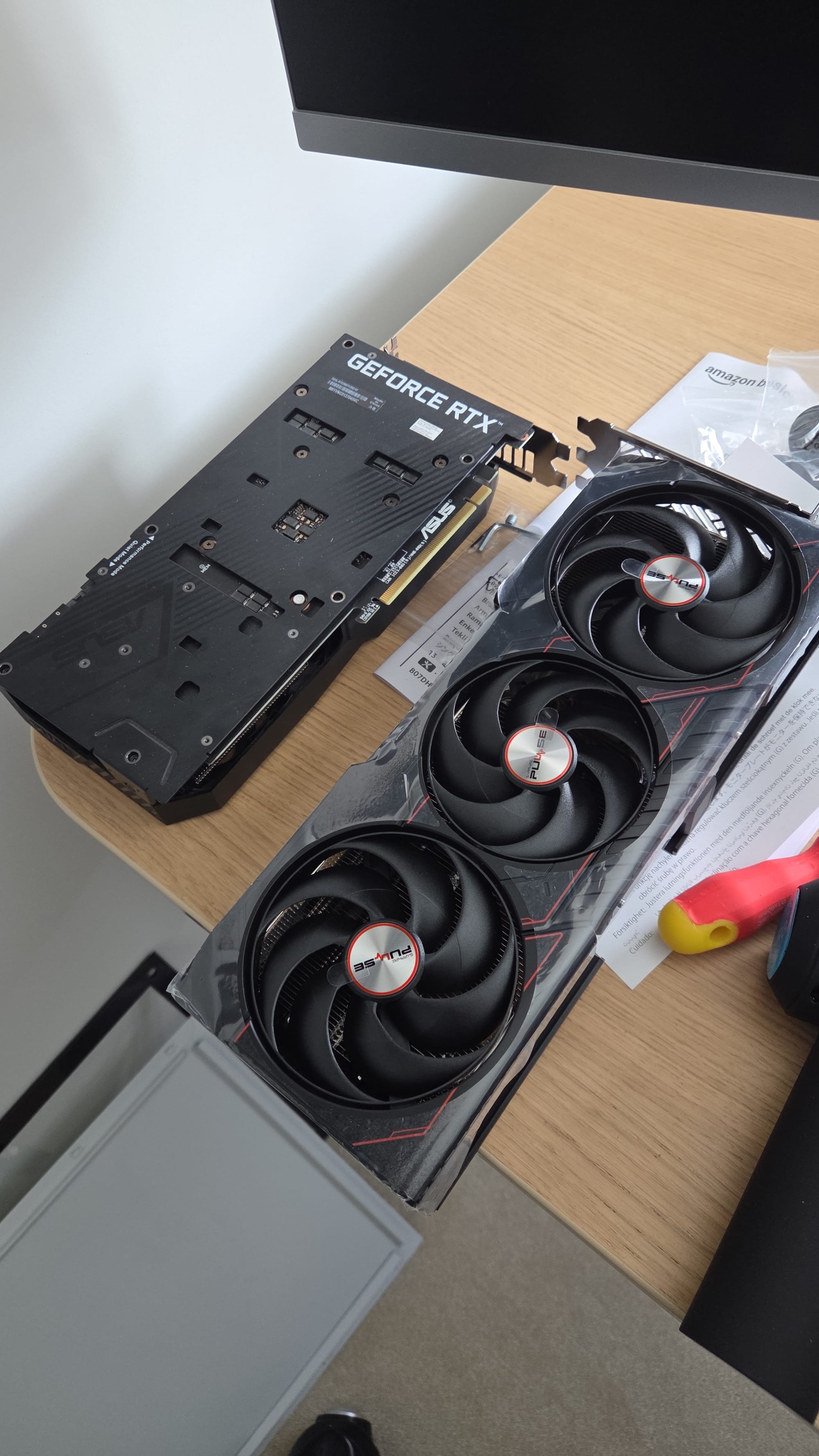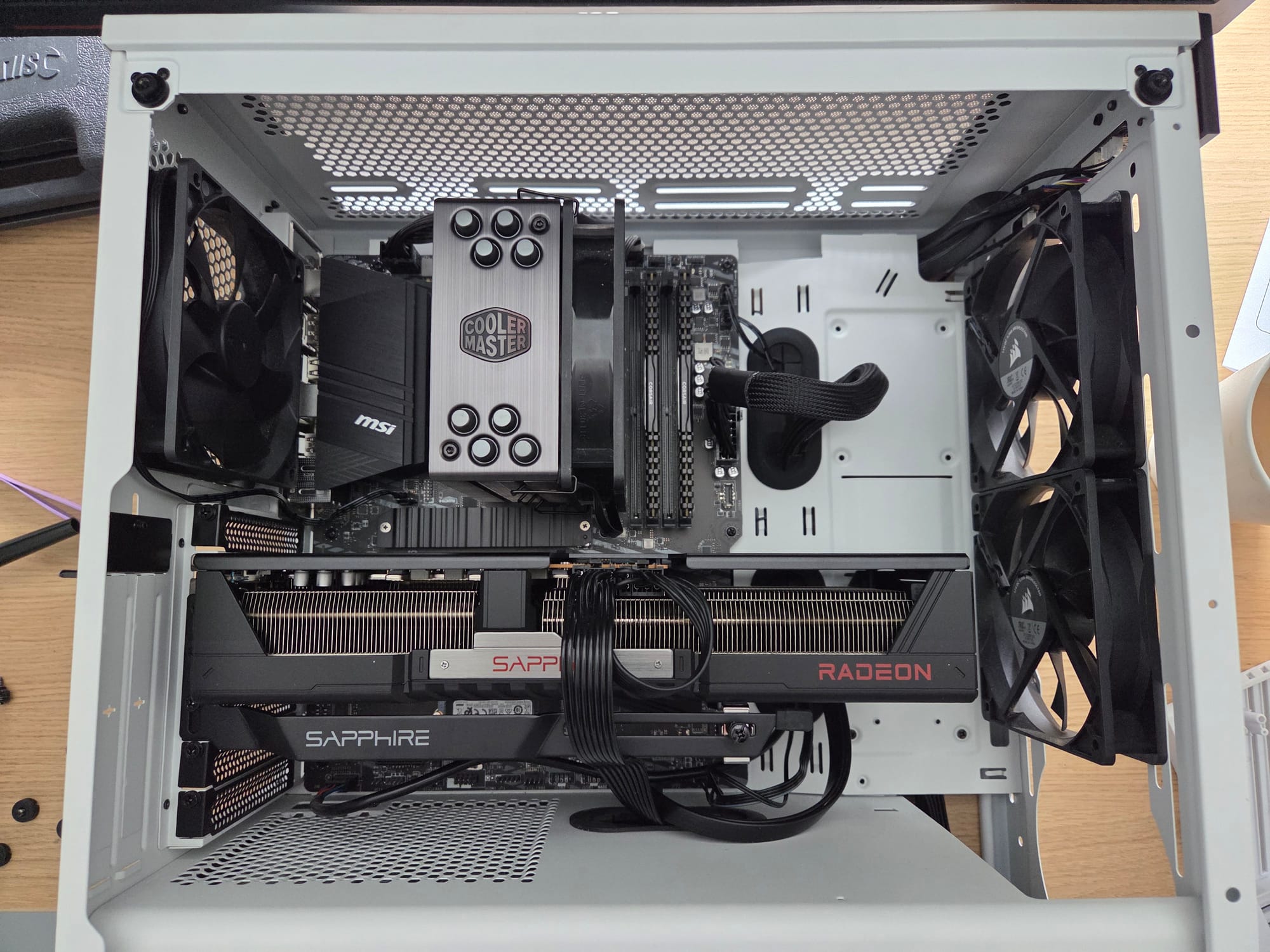Upgrading to a 9070 XT From a 3060Ti Initial Thoughts + Pictures

I built my current PC in the summer of 2021. I set out to update my aging hardware, I’d been running on an i5-4690k, GTX 970 & 8GB of RAM whilst using a Dell XPS laptop for day to day work and I had had enough. Not only was my hardware outdated but switching between two devices whilst working from home was just annoying. So I happily spent many hours plotting my new build, creating several PC Part Picker lists. I had recently got into game development in 2020 and I was experimenting Machine Learning at the time so I was aiming big. I told myself an RTX 3080 would be my aim, the crown jewel of this new beast.
This is the list of parts I'd picked out:
PCPartPicker Part List - 2021But it was, frankly, a terrible time to build a PC. The supply chain issues caused by COVID-19, the rampant crypto mining, the undercurrents of an AI boom slowly bringing itself to boil and of course scalpers (how I loathe them) led to shortages of many parts, especially Graphics Cards.
I couldn’t find a single graphics card in stock anywhere, any that became available quickly sold out, but I could (at a premium) get most of the other parts I wanted, so I pulled the trigger. At the very least I’d be able to use the faithful servant that was the 970 for a while longer.
I scoured the internet every day for months and spent many hours refreshing web pages hoping to get a hold of the crown jewel that my PC desperately needed, the elusive 3080. It never came.
In my desperation I started reaching out to friends, surely someone must have upgraded recently maybe a 20 series was gathering dust? But alas, everyone was in the same boat.
Then I got a text “there’s a GPU on Scan, buy it now!”, I opened the link it was a 3060Ti, a significantly lesser card than I had hoped (or so I thought) and it was £630! I sighed, stood up and got my wallet. It’d have to do.
I must say, I loved that card from the moment I took it out of its box its chunky RTX heft reinforced that this was a major upgrade and the thin purple LED strip oozed class as it whirred to life in my all new build. I appreciated it for what it was, the workhorse that powered my endeavors for 4 years with no complaints and no hiccups, solid.
Taking that card out of my PC for last week left me feeling a bit sad but its replacement the Sapphire AMD 9070XT, acquired for a mere £575, is magnificent.
It is beautiful to look at and fits the overall aesthetic of my build, a clean white and black styling, a nod to my love of clean, simple design and not as a friend put to me "a tribute to shooting with the accuracy of a storm trooper".
I could go on and on about the design and the emotive side of the PC but after all you must be wondering, is the 9070XT any good? Was it worth changing the 3060Ti out for? And how was the switch from team NVIDIA to AMD?
Considerations Before Changing the Card
Before diving into the upgrade, I had to tick off a few important boxes:
1. Will it physically fit in the case?
This sounds obvious, but some modern GPUs are absolute units. I had to double-check measurements and clearance, especially around the PCIe slot and any nearby components.
2. Power supply headroom.
Next up: power. Newer cards can be thirsty, and I had to make sure my PSU had enough wattage and the right connectors. Spoiler: it did, but only just. I probably dodged a future upgrade there.
3. Is it worth the money?
GPUs aren't cheap. I've always got one eye on the GPU market and I compared benchmarks, looked at pricing trends, and weighed up performance per pound. For my needs, a mix of gaming, creative work, and some light ML, this upgrade seemed to hit the sweet spot.
4. What am I losing out on?
Switching from NVIDIA to AMD meant saying goodbye to CUDA cores, which are pretty essential for many ML libraries. That stung a little. But I still have my NVIDIA-powered laptop for when I need to do any serious training, so I wasn’t left high and dry.
What Did I Gain?
1. A longer PC lifespan.
The upgrade gave my aging system a whole new lease of life. It’ll comfortably handle modern games and workflows for a few more years — no need to shell out for a full rebuild (yet).
2. Massive VRAM boost.
The extra VRAM has been a game changer. It’s a blessing for memory-hungry AAA titles, and tools like Blender and Unity feel a lot smoother during asset-heavy scenes.
3. Big frame rate jump.
No surprise here performance is noticeably better across the board. I’m finally hitting high frame rates in games that used to chug.
4. Amazing bang for buck.
Out of all the GPUs this generation, this one might just offer the best value. Sure, it’s not top-tier, but the performance-per-pound ratio is spot on.
5. A good deed.
Lastly, my old 3060Ti didn’t go to waste I passed it on to my nephews. Their old GPU was struggling, and now they’re buzzing with their new gaming rig upgrade. Win-win.

Switching Parts
Physically swapping out the card was pretty straightforward. The new GPU even came with a built-in support bracket, which was a nice touch especially since these newer cards tend to sag more than they used to. Installing it was a breeze.
Power-wise, I was lucky. My 750W PSU already had the right connectors available, so I didn’t have to dig into the cable jungle behind the motherboard which, let’s be honest, is always a last resort.
Software? A bit less plug-and-play.
Here’s where I hit a small bump. I didn’t think to uninstall the NVIDIA drivers before removing the old card. So on first boot with the new AMD card installed, things were... let’s just say "not ideal." A few flickers and a couple of confused error messages later, I realised I needed to clean house.
I came across Display Driver Uninstaller (DDU) a fantastic little tool that clears out every last trace of old GPU drivers. After running that and rebooting, I installed the AMD Adrenalin software, and everything’s been silky smooth since.
Have I Noticed a Difference?
Honestly? Not a dramatic one... yet.
Day-to-day tasks feel just as snappy, and most of the software I use doesn’t seem to push the card hard enough to show a massive difference. That said, I have noticed lower GPU usage in some applications and games, which suggests the new card is coasting through what the old one used to sweat over.
I haven’t had the chance to really stress test it with demanding workloads or long Blender sessions, but that’s definitely coming soon. Once I start pushing it with heavier projects and games, I expect the difference will become much more obvious.
I’ll be doing a proper deep-dive with benchmarks and real-world testing in a future post, stay tuned for that and if you want a notification for when posts go out subscribe!

